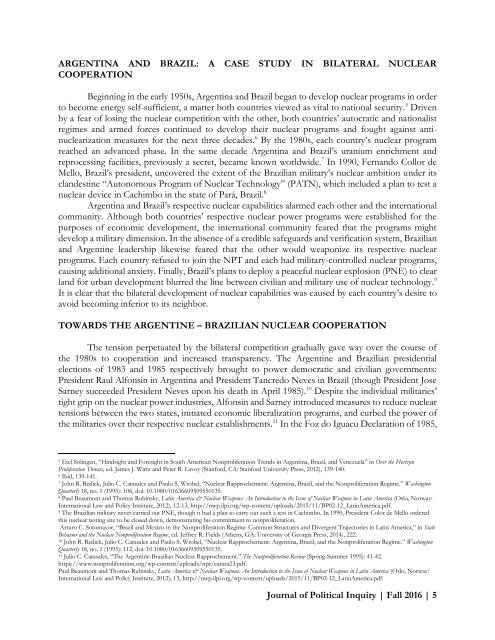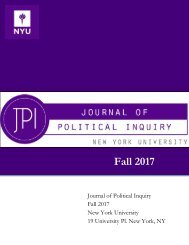Fall2016_Final
Create successful ePaper yourself
Turn your PDF publications into a flip-book with our unique Google optimized e-Paper software.
ARGENTINA AND BRAZIL: A CASE STUDY IN BILATERAL NUCLEAR<br />
COOPERATION<br />
Beginning in the early 1950s, Argentina and Brazil began to develop nuclear programs in order<br />
to become energy self-sufficient, a matter both countries viewed as vital to national security. 5 Driven<br />
by a fear of losing the nuclear competition with the other, both countries’ autocratic and nationalist<br />
regimes and armed forces continued to develop their nuclear programs and fought against antinuclearization<br />
measures for the next three decades. 6 By the 1980s, each country’s nuclear program<br />
reached an advanced phase. In the same decade Argentina and Brazil’s uranium enrichment and<br />
reprocessing facilities, previously a secret, became known worldwide. 7 In 1990, Fernando Collor de<br />
Mello, Brazil’s president, uncovered the extent of the Brazilian military’s nuclear ambition under its<br />
clandestine “Autonomous Program of Nuclear Technology” (PATN), which included a plan to test a<br />
nuclear device in Cachimbo in the state of Pará, Brazil. 8<br />
Argentina and Brazil’s respective nuclear capabilities alarmed each other and the international<br />
community. Although both countries’ respective nuclear power programs were established for the<br />
purposes of economic development, the international community feared that the programs might<br />
develop a military dimension. In the absence of a credible safeguards and verification system, Brazilian<br />
and Argentine leadership likewise feared that the other would weaponize its respective nuclear<br />
programs. Each country refused to join the NPT and each had military-controlled nuclear programs,<br />
causing additional anxiety. <strong>Final</strong>ly, Brazil’s plans to deploy a peaceful nuclear explosion (PNE) to clear<br />
land for urban development blurred the line between civilian and military use of nuclear technology. 9<br />
It is clear that the bilateral development of nuclear capabilities was caused by each country’s desire to<br />
avoid becoming inferior to its neighbor.<br />
TOWARDS THE ARGENTINE – BRAZILIAN NUCLEAR COOPERATION<br />
The tension perpetuated by the bilateral competition gradually gave way over the course of<br />
the 1980s to cooperation and increased transparency. The Argentine and Brazilian presidential<br />
elections of 1983 and 1985 respectively brought to power democratic and civilian governments:<br />
President Raul Alfonsin in Argentina and President Tancredo Neves in Brazil (though President Jose<br />
Sarney succeeded President Neves upon his death in April 1985). 10 Despite the individual militaries’<br />
tight grip on the nuclear power industries, Alfonsin and Sarney introduced measures to reduce nuclear<br />
tensions between the two states, initiated economic liberalization programs, and curbed the power of<br />
the militaries over their respective nuclear establishments. 11 In the Foz do Iguacu Declaration of 1985,<br />
5<br />
Etel Solingen, “Hindsight and Foresight in South American Nonproliferation Trends in Argentina, Brazil, and Venezuela” in Over the Horizon<br />
Proliferation Threats, ed. James J. Wirtz and Peter R. Lavoy (Stanford, CA: Stanford University Press, 2012), 139-140.<br />
6<br />
Ibid, 139-141.<br />
7<br />
John R. Redick, Julio C. Carasales and Paulo S. Wrobel, “Nuclear Rapprochement: Argentina, Brazil, and the Nonproliferation Regime.” Washington<br />
Quarterly 18, no. 1 (1995): 108, doi: 10.1080/01636609509550135.<br />
8<br />
Paul Beaumont and Thomas Rubinsky, Latin America & Nuclear Weapons: An Introduction to the Issue of Nuclear Weapons in Latin America (Oslo, Norway:<br />
International Law and Policy Institute, 2012), 12-13, http://nwp.ilpi.org/wp-content/uploads/2015/11/BP02-12_LatinAmerica.pdf.<br />
9<br />
The Brazilian military never carried out PNE, though it had a plan to carry out such a test in Cachimbo. In 1990, President Color de Mello ordered<br />
this nuclear testing site to be closed down, demonstrating his commitment to nonproliferation.<br />
Arturo C. Sotomayor, “Brazil and Mexico in the Nonproliferation Regime: Common Structures and Divergent Trajectories in Latin America,” in State<br />
Behavior and the Nuclear Nonproliferation Regime, ed. Jeffrey R. Fields (Athens, GA: University of Georgia Press, 2014), 222.<br />
10<br />
John R. Redick, Julio C. Carasales and Paulo S. Wrobel, “Nuclear Rapprochement: Argentina, Brazil, and the Nonproliferation Regime.” Washington<br />
Quarterly 18, no. 1 (1995): 112, doi: 10.1080/01636609509550135.<br />
11<br />
Julio C. Carasales, “The Argentine-Brazilian Nuclear Rapprochement.” The Nonproliferation Review (Spring-Summer 1995): 41-42.<br />
https://www.nonproliferation.org/wp-content/uploads/npr/carasa23.pdf.<br />
Paul Beaumont and Thomas Rubinsky, Latin America & Nuclear Weapons: An Introduction to the Issue of Nuclear Weapons in Latin America (Oslo, Norway:<br />
International Law and Policy Institute, 2012), 13, http://nwp.ilpi.org/wp-content/uploads/2015/11/BP02-12_LatinAmerica.pdf.<br />
Journal of Political Inquiry | Fall 2016 | 5
















